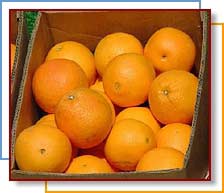
Oranges are highly valued for their vitamin C content. It is a primary source of vitamin C for most Americans. This wonderful fruit
has more to offer nutritionally than just this one nutrient, containing
sufficient amounts of folacin, calcium, potassium, thiamin, niacin and
magnesium. Most of the consumption of oranges is in the form of juice.
Eating the whole fruit provides 140% of the recommended dietary allowance
for vitamin C, less than the juice, but with more fiber, which is not present
in the juice.
 The fruit is technically a hesperidium, a kind of berry. It consists of
several easily separated carpels, or sections, each containing several
seeds and many juice cells, covered by a leathery skin, containing
numerous oil glands. Orange trees are evergreens, seldom exceeding 30 ft
in height. The leaves are oval and glossy and the flowers are white and
fragrant. The fruit is technically a hesperidium, a kind of berry. It consists of
several easily separated carpels, or sections, each containing several
seeds and many juice cells, covered by a leathery skin, containing
numerous oil glands. Orange trees are evergreens, seldom exceeding 30 ft
in height. The leaves are oval and glossy and the flowers are white and
fragrant.
These semitropical evergreens probably originated in Southeast Asia.
Columbus and other European travelers brought sweet orange seed and
seedlings with them to the New World. By 1820 there were groves in St Augustine, Florida, and by the end of the Civil War oranges were being
shipped north in groves. A freeze produced a major set back in production
in 1895, but by 1910 crops in Florida had been reestablished.
Florida is the number one citrus producer, producing 70% of the U.S. crop,
with 90% of that going into juice. However, Arizona, Texas, and California
also produce small amounts, with variations in color and peel. (Wellness
Encyclopedia of Food and Nutrition, 1992).
|
| Oranges |
Serving size
1 medium (140g)
|
Amounts
Per Serving |
% Daily
Value |
| Calories |
70 |
| Calories
from Fat 0 |
0 |
| Total Fat 0g |
0% |
| Sodium 0mg |
0% |
| Potassium
269mg |
7% |
| Total
Carbohydrate 18g |
6% |
|
Dietary Fiber 3g |
11% |
|
Sugars 12g |
|
| Protein 1g |
|
| Vitamin A |
6% |
| Vitamin C |
140% |
| Calcium |
6% |
| Iron |
2% |
* Percent Daily Values are based on a
2,000 calorie diet. |
|
| |
|
All varieties should be firm, heavy for size, and have fine-textured
skin. Look for fruit that is firm and heavy for its size, with bright,
colorful skins. Skin color is not a good guide to quality. Fruits may be
ripe even though they may have green spots. Avoid fruit with bruised,
wrinkled or discolored skins; this indicates the fruit is old or has been
stored incorrectly. Citrus fruit peel may vary in thickness, depending on
weather conditions during the growing season. Thinner skins tend to be
juicier than thick skin fruits.
Oranges can be stored at room temperature, in the refrigerator without
plastic bags or in the crisper drawer for up to 2 weeks. They do not ripen
further after harvest. Fresh-squeezed juice and grated peel or zest may be
refrigerated or frozen, but whole citrus fruit should not be frozen.
Oranges may exhibit some re-greening of the skin; this does not adversely
affect internal fruit quality. Neither does surface scarring, which occurs
when wind brushed young fruit against the tree.
 Varieties include the sweet orange, the sour orange, and the mandarin
orange, or tangerine. The United States produces the sweet variety. Spain
produces the sour variety, Seville, which is used in marmalades and
liqueurs. Most all oranges have a yellow orange color with sizes ranging
from small to large. The inside of an orange is plump and juicy. Sweet
favorites include the Blood, Hamlin, Jaffa, Navel, Pineapple and Valencia. The color depends on the climate. Florida's warm days and
nights produce oranges with some green in the skin coloring. California
and Arizona oranges tend to have deeper orange color due to cooler desert
nights. Varieties include the sweet orange, the sour orange, and the mandarin
orange, or tangerine. The United States produces the sweet variety. Spain
produces the sour variety, Seville, which is used in marmalades and
liqueurs. Most all oranges have a yellow orange color with sizes ranging
from small to large. The inside of an orange is plump and juicy. Sweet
favorites include the Blood, Hamlin, Jaffa, Navel, Pineapple and Valencia. The color depends on the climate. Florida's warm days and
nights produce oranges with some green in the skin coloring. California
and Arizona oranges tend to have deeper orange color due to cooler desert
nights.
The principal varieties of the sweet orange cultivated by orange growers
of the eastern United States are the Hamlin and Parson Brown, both
early-maturing, seedy varieties with thin, russet skin and juicy pulp.
Both eastern and western growers cultivate the Valencia, a late variety
that is commercially seedless. Fresh oranges from California and Arizona
are available throughout the year, with two major varieties, Navels and
Valencias. The Moro orange (a type of blood orange) and the red Cara Navel
are two western-grown seasonal varieties. The Navel orange is a seedless
orange, with medium-thick rind, in which a second small, orange grows. A
variety of the Washington Navel orange is the principal orange product of
Texas.
Recipes

Sweet & Sour Shrimp With Oranges
Makes 4 servings.
Recipe provided by Sunkist Growers.
Ingredients
1 medium onion, coarsely chopped
1 medium green bell pepper, coarsely chopped
3/4 cup ketchup (no salt added)
1/2 Sunkist lemon, peeled and juiced
1 tbsp. cornstarch
3 tbsps. brown sugar
1/2 cup fresh squeeze orange juice
1/4 tsp. ground ginger or 2 tsps. fresh grated ginger root
3 Sunkist oranges, peeled, cut into bite-size pieces
20 small to medium cook shrimp, with tails and shells removed (about 7
ozs.)
3 cups cooked rice (no salt added)
Chopped cilantro or parsley
In large non-stick skillet, spray with no-stick cooking spray, cook
onion and green pepper over medium-high heat until tender but not browned.
Add ketchup, lemon peels, and lemon juice. Blend cornstarch and sugar with
orange juice and ginger; add to sauce. Cook, stirring until thickened. Add
orange pieces and shrimp; heat. Serve over hot-cooked rice. Sprinkle with
chopped cilantro. Serve with lemon wedges, if desired.
Nutritional analysis per serving: Calories 365, Fat 1g, Calories from
Fat 3%, Carbohydrates 77g, Cholesterol 81mg, Fiber 4g, Sodium 110mg,
Protein 14g, Potassium 691mg.

Find more in our
recipe database!
|



